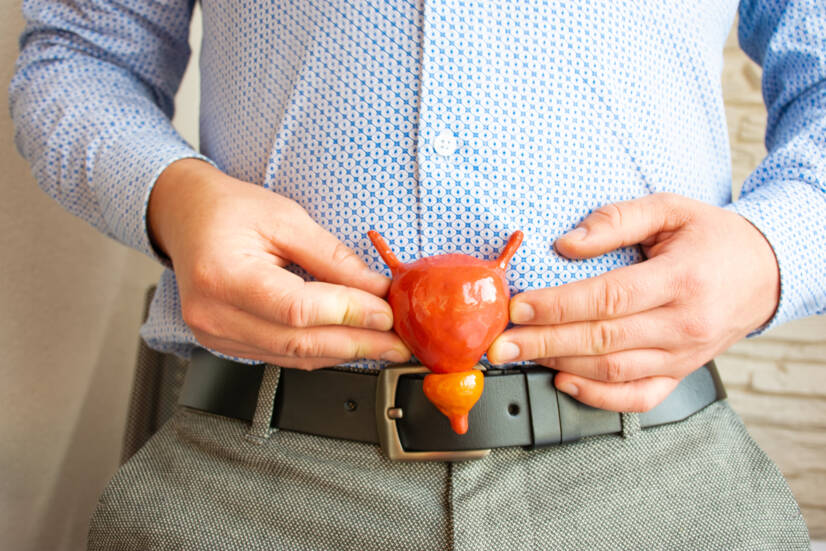- The adult human female prostate homologue and the male prostate gland: a comparative enzyme-histochemical study, Zaviacic, M., Comparative Study, Acta Histochem, 1985;77(1):19-31
- Female prostate: historical, developmental, and morphological perspectives, Biancardi M. F. et al, Cell Biol Int, . 2017 Nov;41(11):1174-1183.
- Common organisms in urogenital infections with special impact on prostatitis. Weidner W., Ludwig M. In: Eur Urol Supplements, 2003, no. 2, p. 15-18.
- Contemporary management of chronic prostatitis/chronic pelvic pain syndrome.Magistro G.et al. In: European urology, 2016, no. 69, p. 286-297.
- NIH consensus definition and classification of prostatitis. Krieger J. N., Nyberg Jr. L., Nickel J. C., JAMA, 1999, p. 236 - 237.
- Guidelines on chronic pelvic pain. European Association of Urology Web site. Engeler D. et al. http://uroweb.org/wp-content/uploads/26-Chronic-Pelvic-Pain_LR. pdf.
- Treatment of the patient with metastatic prostate cancer - from sensitive to castration resistant disease - a case report. Lenko V. In: Onkológia, 2020, p.1.
- Phytotherapy of benign prostatic hyperplasia, Fialova S., In: Via practica, 2013, no. 2
- Anatomy of the human body, Mráz P. et al., 2006. First edition.
- gco.iarc.fr - portal - Global cancer observatory
- solen.sk - LOWER BRAIN INFECTIONS
- solen.sk - Benign prostatic hyperplasia
- solen.sk - Current options for conservative treatment of benign prostatic hyperplasia
- ousa.sk - Treatment options for localized prostate cancer
- solen.sk - Metastatic prostate cancer - new treatment approaches
What is the prostate: what are the possible diseases + How to keep it healthy?

Do you know what a prostate is? It's movember and men's health check-up month is coming up.
Article content
What is the prostate and what is it for? What diseases do we know and what are their symptoms? And much more information is brought to you in the following lines.
In medicine, everything is related to everything. This is also true for an organ as small as the prostate.
Warning signs can be much more extensive than you might expect. At first glance, ordinary back or lower back pain can eventually lead to a urologist.
For many men, this topic is taboo because opening it is mistakenly associated in their minds with a loss of virility. Yet it is not a failure and is often an easily solvable problem.
The aging process is natural, and covering up the symptoms of prostate enlargement will not bring back your youth. On the contrary - if you do not mention the inconvenience, it can have irreversible consequences.
Why? Read on.
Prostate in men
The prostate is a typically male organ. It surrounds the beginning of the male urethra. It is a cone-shaped gland. Its size and weight are key. The most common affliction is age-related benign enlargement.
The dimensions of the male prostate are approximately 4 x 3.5 x 2 cm. The average weight is 20 grams.
The prostate is the largest male accessory sex gland.
It produces a secretion that makes up the first fraction of the ejaculate (10-20% of the volume). This secretion helps to dilute the density of sperm that are expelled into the urethra during ejaculation. The composition of the secretion includes sperm, enzymes, biologically active substances, minerals, and more.
One of the most common questions that many are embarrassed to ask is:
Do women also have a prostate?
Yes, they do.
The female prostate (Prostata femina)
The prostate also exists in women. A description of the female prostate is given by Prof. Zaviačić, MD, DrSc. in 1999.
However, the first mentions appear much earlier. The year 1672 is mentioned in the literature.
The issue of female prostate is still controversial.
Already in 2001, the Federal International Committee on Anatomical Terminology decided to introduce the term female prostate in the new edition of the Histological Terminology.
The female prostate is located in the wall of the female urethra, in close proximity to the anterior wall of the vagina. In women, it makes up approximately 1/5 to 1/4 of the weight of the prostate of the average adult male.
It is also where the maturation of superficial, so-called epithelial gland cells into mature secretory cells occurs. The exocrine (excretory) function ensures the production of prostatic fluid.
The so-called neuroendocrine function has also been described. However, its demonstration is subject to further research and further clarification.
The results concerning the biological function may bring surprising advances among gynaecological-urological disorders occurring in women.
When the urethra is injured in a fall on the perineal area, the severity of the injury may vary. Isolated injuries to the female prostate are virtually non-existent.
Studies have been published describing rare cases of cysts, hyperplasia (nonmalignant, benign enlargement), and carcinoma (malignancy) of the prostate in women.
What are the most common prostate diseases in men?
The most common "groups" of diseases:
- Injuries
- Inflammation
- benign enlargement of the prostate
- malignant prostate tumor
Myth: "I can urinate, I don't have a prostate..."
To better understand prostate disease, let's briefly review the diagnostic options.
1.
During the interview with the doctor, you thoroughly describe your health problems.
This step is crucial in the diagnosis of any disease. On the basis of this information, the next course of action unfolds.
People tend to withhold information when they have difficulty with urination, bowel movements, genitalia or in general in intimate matters.
This information is important to the doctor. Don't be afraid to talk about it. After all, it is your health. Inaccurate information about the occurrence of the first or subsequent symptoms will ultimately harm your health.
2. The second step - physical examination
The doctor will assess your overall health. He or she will focus on a basic urological examination. The actual examination of the prostate involves a so-called digital examination (the doctor reaches a finger through the rectum to palpate the prostate).
3. Further diagnostic steps
Urinalysis, laboratory blood tests and imaging - X-ray, USG (ultrasound of the prostate or abdomen), CT (computed tomography), MRI (magnetic resonance imaging), radionuclide scan (PET-CT).
Urological investigative options are extensive, instrumental examinations (e.g. coiling), urodynamic examinations (monitoring possible urine transport disorders), direct tissue sampling and more.

Inflammation
Inflammation of the prostate, called prostatitis, is a broader term. It includes:
- Acute bacterial inflammation of the prostate.
- chronic bacterial prostatitis
- Prostatitis syndrome, also called chronic non-bacterial prostatitis or chronic pelvic pain syndrome
- asymptomatic prostatitis - histological finding (finding in tissue)
Explain the different forms of inflammatory involvement of the prostate.
Acute form of bacterial inflammation of the prostate (acute prostatitis)
It belongs to lower urinary tract infections.
Symptoms:
- Frequent, urgent urination
- pain in the perineum, lower abdomen or external genital area
- fever, chills
- weak urine stream to inability to urinate (urinary retention)
If the urine flow is impaired or impossible, the urinary tract may become blocked, called obstruction!
A specialist doctor (urologist) during a digital examination (finger examination through the rectum) finds swelling, leakage and the patient feels soreness.
A positive bacterial finding (most often Escherichia coli) is common in the urinalysis.
On ultrasound examination, there may be a finding of post-urinary residue. This means that after urination, residual urine remains in the bladder and damage to the organism occurs.
If significant urine residue or acute urinary retention is present in acute prostatitis, an epicystotomy (a procedure that allows urine to drain by opening the bladder) may be necessary.
Treatment of acute prostatitis depends on the severity of the clinical condition.
Most often, treatment with antibiotics is based on the sensitivity of the findings in the urine.
Chronic bacterial inflammation of the prostate (chronic prostatitis)
Compared with acute inflammation, chronic inflammation has a more insidious course.
It is characterized by repeated infections.
Chronic prostatitis is considered the most common cause of recurrent urinary tract infections in men. Very often, the acute form is not treated adequately.
Symptoms:
- Urinary disorders, frequent urination
- Urgent urination
- non-specific pain in the perineum or genital area
- no symptoms may be present
Diagnosis depends on recurrence of prostatitis and treatment of chronic prostatitis is long term.
The duration of treatment should be at least 2 weeks. Do not discontinue treatment when clinical symptoms improve; it should last 4 to 6 weeks.
As with acute inflammation, antibiotic treatment is used according to the findings of microorganisms. The preferred antibiotic is ciprofloxacin.
Often, because of obstructive penetration of the antibiotic into the tissue or some isolation of the bacterial foci, complete cure may not be achieved.
Chronic non-bacterial prostatitis (chronic pelvic pain syndrome)
Presents discomfort, pelvic pain or sexual dysfunction lasting at least 3 of the last 6 months. A comprehensive diagnosis is required to exclude other causes (bacterial inflammation, cancer, neurological disease, various anatomical abnormalities, etc.).
The clinical picture of the discomfort itself, pelvic pain, sexual disorders, even mood and behavioural changes is very varied.
The causes of occurrence are distinguished by the presence of an inflammatory component. They are not sufficiently clarified, which makes treatment itself difficult.
Treatment options are still the subject of many studies. Antibiotics, anti-inflammatory drugs, drugs of the so-called alpha-blocker type, hormonal inhibition (attenuation), herbal preparations and physical therapy are used in practice.
What is BPH?
BPH is a benign enlargement of the prostate called benign prostatic hyperplasia.
The abbreviation is derived from the English benign prostatic hyperplasia.
During the natural aging process, cells in the prostate area (muscle and surface cells, called epithelial cells) multiply, and therefore their accumulation leads to prostate enlargement.
It is a common, slowly progressive disease, affecting mainly older men. The incidence increases after the age of 50. In the literature, it has been described that up to 90% of men suffer from BPH in the 1980s.
BPH does not mean prostate cancer. Prostate enlargement can occur with prostate cancer.
Manifestations of an enlarged prostate
An enlarged prostate presses on the urethra and there is impaired emptying of the bladder.
Symptoms of varying degrees of impaired emptying are conditioned by this mechanism.
Manifestations of deposition disorders (irritative)
- frequent urination during the day
- frequent urination at night
- Urgent urination to leakage of urine
Manifestations of voiding disorders (obstructive)
- weak urine stream
- intermittent urination
- prolonged urination
- Urge urination
Post voiding symptoms (symptoms after urination)
- feeling of incomplete urination
- dripping after urination
Sexual dysfunction
Diagnosis is based on the history in the first step. It is very helpful to fill in the International Patient Survey Questionnaire (IPSS) correctly (7 questions related to urinary difficulties, according to the severity classification score).
The questionnaire also includes a question about your quality of life.
This is followed by a physical examination of your prostate by your doctor, laboratory tests (including a PSA test) and imaging.
It may also include a measurement of urine flow through the urethra called uroflowmetry, measurement of residual urine and, if there is bleeding, a cystoscopy of the bladder.
Pressure urine flow testing will also help differentiate BPH from bladder muscle weakness.
In practice, a voiding diary is also very useful, which describes the frequency of voiding and the volume of urine.
Treatment of BPH
Regular monitoring of the patient, called dispensary care, is part of the treatment.
Lessons on lifestyle changes in BPH
Limit sedentary lifestyle. Do not consume irritants such as alcohol and coffee before bedtime, and reduce fluid intake to only before bedtime.
It is important to make sure you urinate thoroughly and try to urinate at regular intervals.
Do not delay urination, e.g. when travelling!
However, during urges to urinate, practise holding back to maintain bladder capacity.
Pharmacological treatment consists of taking 5-alpha-reductase inhibitors (inhibits the conversion of testosterone to another form, inhibits tissue growth), alpha-blockers that reduce the pressure of the prostate on the bladder, antimuscarinic drugs and other types, combinations of several groups of drugs, herbal extracts.
Surgery is indicated in case of failure of conservative treatment.
Do not immediately imagine a large open surgery.
In today's medicine, non-invasive interventions performed through the urethra of the patient are already available. Other options are laser operations, laparoscopic operations.
Prostate cancer
Prostate cancer is the second most common cancer in men worldwide.
Unlike BPH, prostate cancer involves the uncontrolled growth of abnormal cells in the prostate tissue. Most arise from glandular cells of the prostate. This type of cancer is called adenocarcinoma. Many of these types of tumors are slow-growing, but we also encounter aggressively fast-growing types.
There are several histological types of prostate cancer according to the types of cells that undergo malignant transformation.
Symptoms of prostate cancer
Early stages may not show any symptoms.
Therefore, regular preventive check-ups will help you detect the disease early!
The most common symptoms:
- More frequent urination at night and/or during the day
- difficulty urinating
- urge to urinate
- changes in urine flow
- leakage (incontinence) of urine
- blood in the urine (haematuria)
- erectile dysfunction
- blood in the ejaculate
- pain in the pelvic area, lower back, back pain
- general weakness, lack of appetite and weight loss
- specific symptoms associated with the presence of distant secondary lesions (metastases)
Often men think that they have "only" long term pain in the spine, especially in the lower back. Unfortunately, in some cases it is bone metastases in prostate cancer!
Diagnosis
A palpation of the prostate by a urologist, an ultrasound examination and, if necessary, a fine needle biopsy are essential.
PSA a great help!
What is PSA?
Prostate-specific antigen is an indicator (biomarker) whose level in the blood and its dynamics point to a pathological process in the prostate.
The level just reflects a possible malignant degeneration. In oncology, it is particularly beneficial in diagnostic and therapeutic management.
A slight increase in PSA alone does not always mean prostate cancer!
It often helps to detect prostate cancer even at a localized stage.
Sometimes the PSA level and its monitoring over time influences the physician's decision at a time when no imaging test can yet provide the necessary information about the prostate.
The biopsy results include the Gleason scale, a classification of the extent of prostate cancer cells.
When to take the PSA?
If there is a positive family history, men over 40 years of age should have a preventive PSA sampling.
In men over 50 years of age, as part of standard prevention from public health insurance.
However, some commercial insurers cover PSA collection earlier, from the age of 40.
If you have problems, don't look to see if you meet the age criteria. See a urologist who will examine you in the first instance and possibly indicate a collection.
Take advantage of this option.
Other diagnostic options have been described above.
Treatment
Thanks to advances in medicine, we have a better understanding of the biological basis of prostate disease. This brings new treatment options, extending patients' lives and improving their quality of life.
Treatment and prognosis depend on the stage of detection of the disease.
New options include surgery, hormone therapy, radiotherapy, chemotherapy, combination and targeted therapy.
With surgery, the goal is to remove the tumor.
The extent of the procedure (removal of part of the prostate, the whole prostate or resection of an adjacent organ) depends on the location and penetration of the tumour mass.
Hormonal treatment involves blocking hormones called androgens ( testosterone in men). Suppressing androgens slows and stops the growth of malignant (cancerous) cells.
In treatment, you will encounter the term brachytherapy, also referred to as internal radiation. Prostate treatment takes advantage of the fact that the radiation source is directly near the area being treated and delivers the high dose of radiation needed to the target tissue.
External beam radiotherapy is also used in the treatment (radiation is produced in a device called a linear accelerator and the radiation reaches the patient through the skin).
Nuclear therapy may use special radioactive substances in certain indications. These are delivered by the blood to the cancer site and there release radiation capable of destroying the cancer cells. One option may be radium-223, the so-called alpha emitter, which allows high treatment effectiveness with low toxicity.
Ongoing intensive clinical research in oncology also focuses on the use of the body's immunological response against cancer cells, so-called immunotherapy. Stimulation of immune cells directly against prostate cancer cells continues to be the subject of clinical trials.
How to keep the prostate healthy?
The answer is prevention. A healthy lifestyle.
- Get moving.
- Reduce alcohol and caffeine intake
- Don't smoke
- Adequate fluid intake

Prostate and natural medicine
Phytotherapy relies on plant extracts and natural substances containing fatty acids and phytosterols that have a beneficial effect on the prostate.
It has comparable effects to some medicated drugs. In vitro (in test tubes) studies suggest that plants may exert anti-inflammatory, anti-androgenic, estrogenic and similar mechanisms.
These findings have not been conclusively demonstrated in vivo (in a living organism). The exact mechanism and effect of plant preparations remains unclear.
Different manufacturers vary in the techniques of extraction of herbs, the ratio of quantity and quality, and therefore the clinical effect may vary considerably.
Don't be fooled!
Unfortunately, most herbal preparations especially on the internet may not contain the actual herbal extract at all or in minimal amounts.
The excipients in such "pseudo" preparations often have no real data at all and may even be harmful to health.
Always check the herbal product and the manufacturer!
Many manufacturers have no problem declaring misleading claims on the packaging. They can afford to do so because their product may not be subject to proper controls.
Check with your pharmacist and/or doctor to find out what percentage the product actually contains.
Tip and recommendation: buy pure dried herb! Buy books on herbs from real experts!
It is difficult to make an unequivocally valid analysis of an extract from one plant. At the same time, it is therefore difficult to determine the exact specific dosage.

In phytotherapy, common pumpkin, little willow, saw palmetto, African plum, rye and stinging nettle are often used.
Interesting resources
Related










